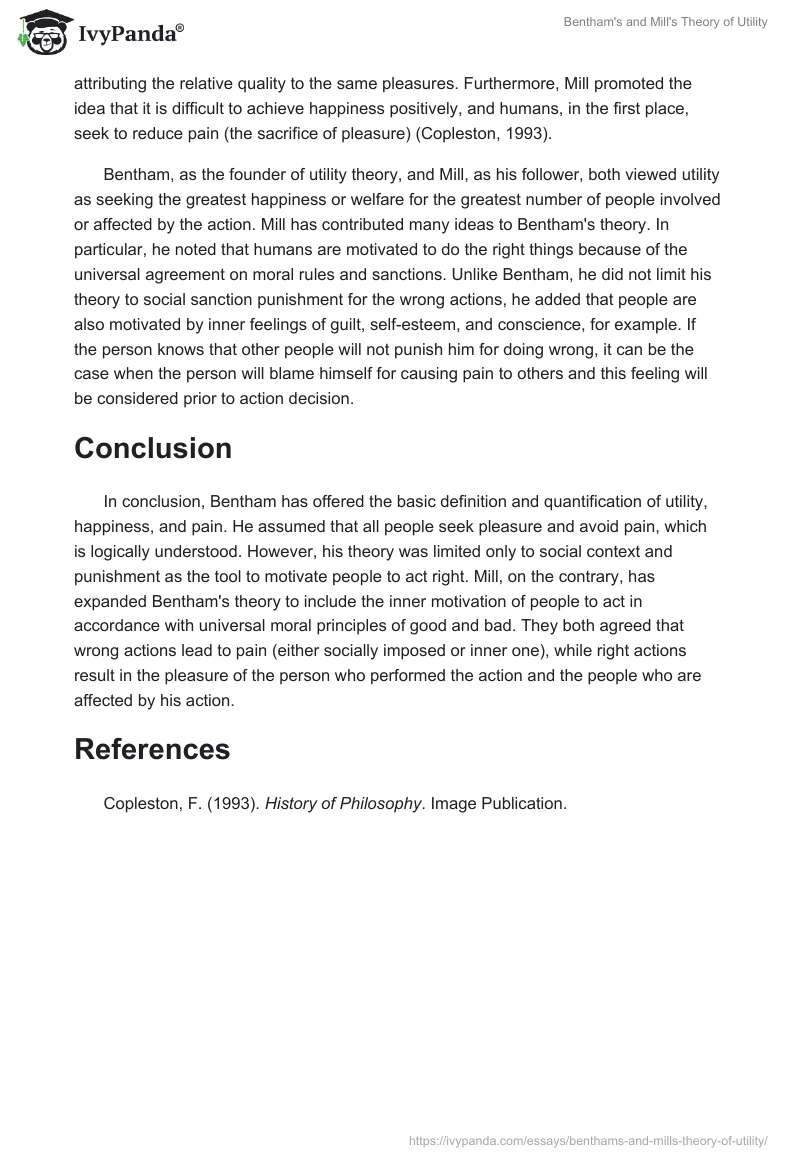Introduction
Utilitarianism is the belief that the worth of moral action is determined only by its outcome. In general, utility is determined as happiness. Bentham, the follower of Hume, proposed the quantification of morality with reference to utility (the result of the action). His theory was founded on the belief that the result of human action counts for their happiness and each action results either in the achievement of happiness or in avoidance of suffering. He offered the following quantification of utility: the intensity with which the happiness is felt (how long it lasts, how quickly it appears after the action, and how likely it contributes to pain avoidance).
Main body
Bentham assumed that the pleasure of community is the total pleasure of individuals. In other words, his theory of utility is based on the principle of moral obligation: the greatest pleasure for the greatest number of people who are involved or affected by the action performed by one individual. Social policies, for example, are evaluated using Bentham’s definition of utility. Thus, punishing the criminals is one of the ways to reduce crime because criminals are punished for the outcome of their actions (punishment is attached to emotional pain as the result of criminal activity) (Copleston, 1993).
John Mill was raised on the principles of Bentham and devoted his life to the promotion of welfare for all. In his book Utilitarianism published in 1861, he noted that it is commonly agreed that the results of human actions contribute to the moral value attached to them. Mill totally agreed with Bentham and considered the principle of the greatest happiness for the greatest number of people as the basic value of utilitarianism. Thus, actions can be considered right only if they contribute to happiness, and they are wrong if they lead to the reverse effect. Nevertheless, he did not agree with the quantification offered by Bentham. He believed that the differences among pleasure cannot be quantified. For example, he wrote that pleasure experienced by different people can be different from each other, however, all people are capable of attributing the relative quality to the same pleasures. Furthermore, Mill promoted the idea that it is difficult to achieve happiness positively, and humans, in the first place, seek to reduce pain (the sacrifice of pleasure) (Copleston, 1993).
Bentham, as the founder of utility theory, and Mill, as his follower, both viewed utility as seeking the greatest happiness or welfare for the greatest number of people involved or affected by the action. Mill has contributed many ideas to Bentham’s theory. In particular, he noted that humans are motivated to do the right things because of the universal agreement on moral rules and sanctions. Unlike Bentham, he did not limit his theory to social sanction punishment for the wrong actions, he added that people are also motivated by inner feelings of guilt, self-esteem, and conscience, for example. If the person knows that other people will not punish him for doing wrong, it can be the case when the person will blame himself for causing pain to others and this feeling will be considered prior to action decision.
Conclusion
In conclusion, Bentham has offered the basic definition and quantification of utility, happiness, and pain. He assumed that all people seek pleasure and avoid pain, which is logically understood. However, his theory was limited only to social context and punishment as the tool to motivate people to act right. Mill, on the contrary, has expanded Bentham’s theory to include the inner motivation of people to act in accordance with universal moral principles of good and bad. They both agreed that wrong actions lead to pain (either socially imposed or inner one), while right actions result in the pleasure of the person who performed the action and the people who are affected by his action.
References
Copleston, F. (1993). History of Philosophy. Image Publication.


